|
living:
autocade
 Muscles
in a suit Muscles
in a suit
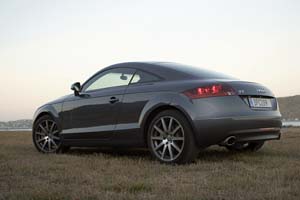
The new Audi
TT is safe for men—stylish and more masculine than its predecessor,
according to Jack Yan
photographed by Douglas
Rimington
Expanded from issue
23 of Lucire
PHOTOGRAPHER Douglas
Rimington said he would not consider getting into the Audi TT
that I had been loaned if it had been the first-generation model.
Therein lies the rub. The first-generation TT
might have been a style icon of the 1990s, redefining what were
acceptable proportions for a sports car, but it came as part of
a wave that included the BMW Z3
and the Porsche Boxster.
The Boxster was already thought of as a sub-911,
a replacement for the 924 lineage that seemed either too feminine
or too London-yuppie. The Z3 was the
sort of car that men would drive in America, while other men in
Camaros pulled up next to them and called out, ‘Faggot.’ To make
it worse, Pierce Brosnan drove one in Goldeneye. A wimpy
car for a wimpy Bond.
We men are too sensitive about our sexuality.
Most heterosexual men (well, OK, maybe
a few of us) possess some degree of homophobia. Therefore, a car
that defied the long hood-short deck idea that had been biologically
programmed into us as resembling a phallic symbol would instantly
earn an unfair moniker, regardless of its competence. And that was
the TT. It was a polite sports car,
able to dish out the power through a Golf platform, but ultimately
it was a Golf in a party frock. It was the David Hyde Pierce of
sports cars. Straight, but not butch.
This fact, I am sure, was not lost on the Ingolstadt
marketing department. After all, most of that business is male,
including Walter da’Silva, Audi’s former design director who had
pioneered the gaping-mouth grille (Lucire November 2004).
Already, that would make the cars more male. But the proportions—the
one thing that made homophobes cry out, ‘It’s gay’—needed changing
without upsetting the sexuality-secure buyers who bought the original.
The TT was an icon, the first sports
car that showed that a curved roof need not belong on a Volkswagen
Käfer. And you do not mess with icons. Plastic surgeons
might try to make local women look more and more like Lorraine Downes
with each visit, but Claudia Schiffer must always look like Claudia
Schiffer.
So, Audi made the new TT
wider and longer, but no higher. The bulbous surfaces of the original
were tautened. The design language is different, when you go close
up and look at the profile of the new car. These are muscles underneath
a Hugo Boss suit, and if we men cannot have a phallic-symbol car,
we might as well have one that is muscular. The lights are trapezoidal,
slanting into the grille. Down the back, where the greatest changes
had taken place, the designers made the automotive rear end look
less like a human rear end. The TT,
in this incarnation, is a tougher machine, still recognizable as
a TT, but no longer girly.
The funny thing is, this appeals to women, too.
As I said once on Good Morning, women buy cars like the Suzuki
XL-7 because the wings, or fenders,
look muscular, like pectoral muscles. (Men are drawn to long, slinky
shapes that are curvy.) Audi has created a car that has the masculinity
that complements a man, but which also draws women. It just so happens
that it has used a far better platform and a powertrain that cry
out a sporting message.
We had the 3·2 quattro (Audi asks that it be spelt
in lowercase). If it has a Golf platform, then we sure as heck didn’t
recognize it. Built on the Audi aluminium space frame, it was brimming
with high-tech features, including a magnetic damper system that
uses particles inside the shock absorbers to make the suspension
firmer.
The gearbox can arouse most of us fellas. I had
driven sequential ’boxes before: the TT’s
flappy paddle change comes close to the Porsche 911’s. The changes
are quick, and should have its rivals worried.
The seats are comfortable: the adjustable lumbar
support and the firm headrest keep the seats hard in the right places.
I had no complaints about driving long distances in the TT:
a point that more expensive sports cars had disappointed me on.
It is not, however, a load-lugger. There is room
for bags for a young couple to have a weekend away, but I had to
unpack a grass trimmer for it to fit inside the boot. Not that a
typical buyer would take the TT to
Mitre 10. But this was a comprehensive road test, and it was my
duty. (A minor niggle is opening the boot: when keyless, I do not
expect to have to open the door to find the release.)
There is one aspect of the TT
that still suggests it is a car in a suit. The four-wheel-drive
transmission keeps it firm on the ground, so while you can still
make it turn a wheel in anger, it never loses composure. For those
wanting to throw the back out for fun, think again. The grip comes
from the power being applied to all wheels, and from traction control.
Boy racers can look elsewhere, and that is good news.
It has all those little details, like cufflinks.
The TT logo on the fuel filler flap.
The straight-bottom steering wheel (not quartic)—in fact, the steering
wheel itself is an iconic piece of design.
Most importantly, no man need worry about driving
the second-generation Audi TT. Doug
and I looked like two straight blokes in this motor. No nutter would
wind down his window except to give the car an admiring glance—and
many did. The good news is that the girls told us they liked this
car. So, the pull factor is high. If you happened to be single.
Maybe I should have lent it to Doug on a swimwear photo shoot. •
|
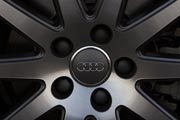
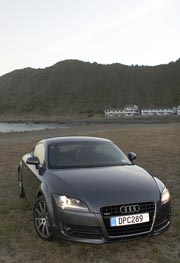
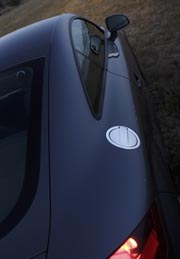
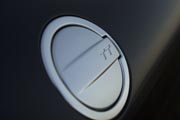
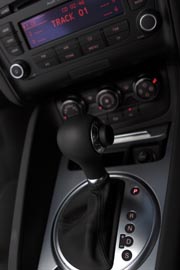
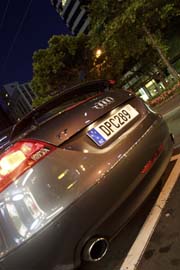
Photographed by Douglas
Rimington
|

